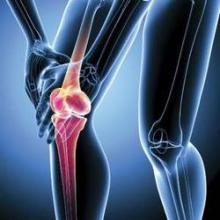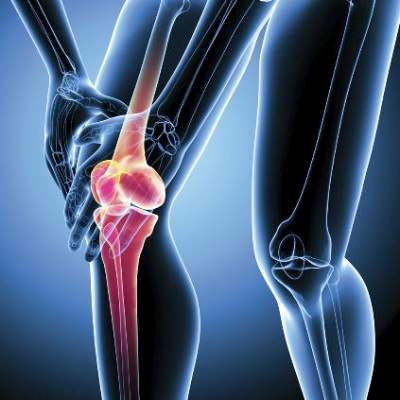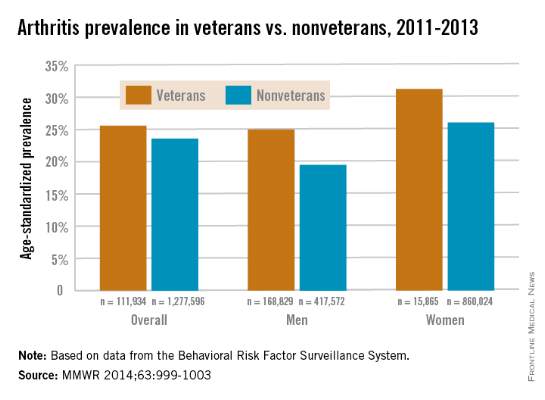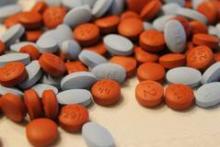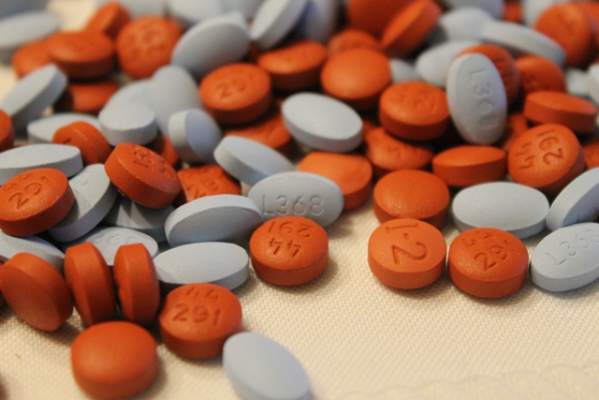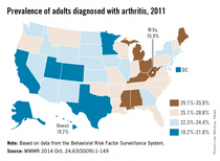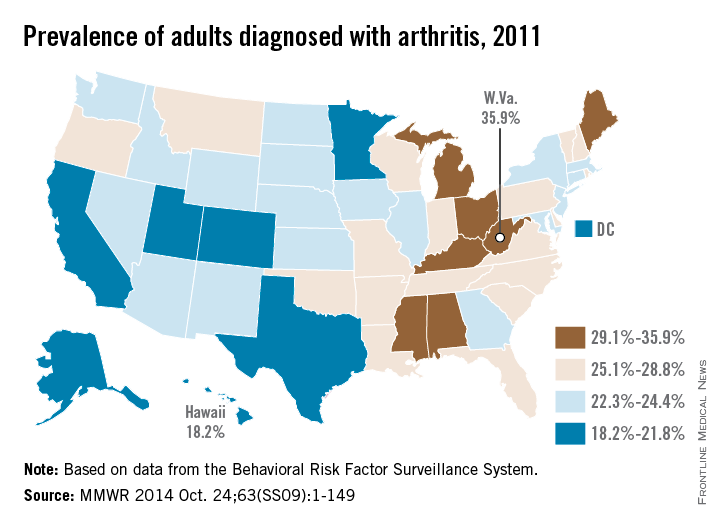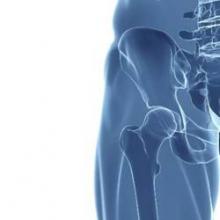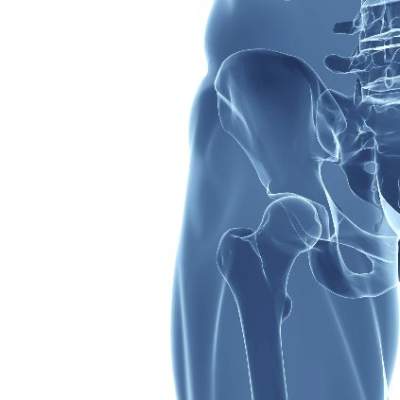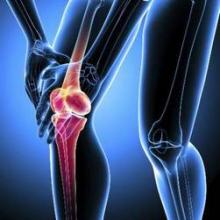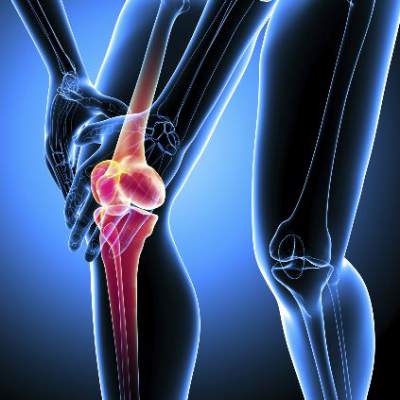User login
For MD-IQ on Family Practice News, but a regular topic for Rheumatology News
Intra-articular better than oral therapies for knee OA?
Intra-articular treatments appear to be more effective than oral therapies for knee osteoarthritis, but that may be due to their greater placebo effect, according to a report published online Jan. 5, 2015, in the Annals of Internal Medicine.
Until now, the relative effectiveness of various OA treatments has been difficult to discern, in part because few studies have offered direct head-to-head comparisons, and traditional meta-analysis techniques “cannot integrate all of the evidence from several comparators.” So researchers used a network meta-analysis design that enabled multiple comparisons among five oral agents (acetaminophen, diclofenac, ibuprofen, naproxen, and celecoxib), two intra-articular agents (corticosteroids and hyaluronic acid), and two placebos. They included 137 randomized controlled trials involving 33,243 adults with primary knee OA who were treated for at least 3 months between 1980 and 2014, said Dr. Raveendhara R. Bannuru, director of the center for treatment comparison and integrative analysis, at Tufts Medical Center's Institute for Clinical Research and Health Policy Studies, Boston, and his associates.
All the treatments except acetaminophen produced clinically significant improvement in pain. Both of the intra-articular treatments, with effect sizes of up to 0.63, were superior to all of the oral treatments, with effect sizes as low as 0.18. Most striking was the finding that intra-articular hyaluronic acid was the most effective treatment of all, since it is “generally considered by expert panels to be minimally effective.” But this may be because intra-articular delivery itself was found to have a significant placebo effect (effect size of 0.29) – a result that traditional meta-analysis could not have revealed, the investigators said (Ann. Intern. Med. 2015 Jan. 5 [doi:10.7326/M14-1231]).
The study findings raise important questions about whether this is a true placebo response or a physiologic effect from injecting fluid into the knee joint. “Regardless of the mechanism of the apparent benefit attributable to needle placement in the knee, the practical reality is that this procedure contributes to the overall benefit conferred in clinical practice,” Dr. Bannuru and his associates noted.
“This information, along with the safety profiles and relative costs of [the] treatments, should be helpful to clinicians when making care decisions tailored to individual patient needs,” they wrote.
This study was supported by a grant from the U.S. Agency for Healthcare Research and Quality. Dr. Bannuru’s associates reported ties to the Patient-Centered Outcomes Research Institute, the National Center for Complementary and Alternative Medicine, the European League Against Rheumatism, Croma, Flexion Therapeutics, and Bioventus.
The brief treatment time of the studies included in this network meta-analysis – as short as 3 months – is an important limitation, and efficacy estimates calculated from such a short time frame may not be accurate.
Moreover, treatment durability is a crucial factor in a chronic disease such as knee OA. Long-term treatment responses cannot be determined from short-term trials, and more than half of OA pain studies, as well as more than 80% of industry-sponsored studies, are less than 6 months in duration.
Dr. Lisa A. Mandl is at the Hospital for Special Surgery, Weill Cornell Medical Center, New York. Elena Losina, Ph.D., is at Brigham and Women’s Hospital and Harvard Medical School, Boston. They made these remarks in an editorial accompanying Dr. Bannuru’s report (Ann. Intern. Med. 2015 Jan. 5 [doi:10.7326/M14-2636]).
The brief treatment time of the studies included in this network meta-analysis – as short as 3 months – is an important limitation, and efficacy estimates calculated from such a short time frame may not be accurate.
Moreover, treatment durability is a crucial factor in a chronic disease such as knee OA. Long-term treatment responses cannot be determined from short-term trials, and more than half of OA pain studies, as well as more than 80% of industry-sponsored studies, are less than 6 months in duration.
Dr. Lisa A. Mandl is at the Hospital for Special Surgery, Weill Cornell Medical Center, New York. Elena Losina, Ph.D., is at Brigham and Women’s Hospital and Harvard Medical School, Boston. They made these remarks in an editorial accompanying Dr. Bannuru’s report (Ann. Intern. Med. 2015 Jan. 5 [doi:10.7326/M14-2636]).
The brief treatment time of the studies included in this network meta-analysis – as short as 3 months – is an important limitation, and efficacy estimates calculated from such a short time frame may not be accurate.
Moreover, treatment durability is a crucial factor in a chronic disease such as knee OA. Long-term treatment responses cannot be determined from short-term trials, and more than half of OA pain studies, as well as more than 80% of industry-sponsored studies, are less than 6 months in duration.
Dr. Lisa A. Mandl is at the Hospital for Special Surgery, Weill Cornell Medical Center, New York. Elena Losina, Ph.D., is at Brigham and Women’s Hospital and Harvard Medical School, Boston. They made these remarks in an editorial accompanying Dr. Bannuru’s report (Ann. Intern. Med. 2015 Jan. 5 [doi:10.7326/M14-2636]).
Intra-articular treatments appear to be more effective than oral therapies for knee osteoarthritis, but that may be due to their greater placebo effect, according to a report published online Jan. 5, 2015, in the Annals of Internal Medicine.
Until now, the relative effectiveness of various OA treatments has been difficult to discern, in part because few studies have offered direct head-to-head comparisons, and traditional meta-analysis techniques “cannot integrate all of the evidence from several comparators.” So researchers used a network meta-analysis design that enabled multiple comparisons among five oral agents (acetaminophen, diclofenac, ibuprofen, naproxen, and celecoxib), two intra-articular agents (corticosteroids and hyaluronic acid), and two placebos. They included 137 randomized controlled trials involving 33,243 adults with primary knee OA who were treated for at least 3 months between 1980 and 2014, said Dr. Raveendhara R. Bannuru, director of the center for treatment comparison and integrative analysis, at Tufts Medical Center's Institute for Clinical Research and Health Policy Studies, Boston, and his associates.
All the treatments except acetaminophen produced clinically significant improvement in pain. Both of the intra-articular treatments, with effect sizes of up to 0.63, were superior to all of the oral treatments, with effect sizes as low as 0.18. Most striking was the finding that intra-articular hyaluronic acid was the most effective treatment of all, since it is “generally considered by expert panels to be minimally effective.” But this may be because intra-articular delivery itself was found to have a significant placebo effect (effect size of 0.29) – a result that traditional meta-analysis could not have revealed, the investigators said (Ann. Intern. Med. 2015 Jan. 5 [doi:10.7326/M14-1231]).
The study findings raise important questions about whether this is a true placebo response or a physiologic effect from injecting fluid into the knee joint. “Regardless of the mechanism of the apparent benefit attributable to needle placement in the knee, the practical reality is that this procedure contributes to the overall benefit conferred in clinical practice,” Dr. Bannuru and his associates noted.
“This information, along with the safety profiles and relative costs of [the] treatments, should be helpful to clinicians when making care decisions tailored to individual patient needs,” they wrote.
This study was supported by a grant from the U.S. Agency for Healthcare Research and Quality. Dr. Bannuru’s associates reported ties to the Patient-Centered Outcomes Research Institute, the National Center for Complementary and Alternative Medicine, the European League Against Rheumatism, Croma, Flexion Therapeutics, and Bioventus.
Intra-articular treatments appear to be more effective than oral therapies for knee osteoarthritis, but that may be due to their greater placebo effect, according to a report published online Jan. 5, 2015, in the Annals of Internal Medicine.
Until now, the relative effectiveness of various OA treatments has been difficult to discern, in part because few studies have offered direct head-to-head comparisons, and traditional meta-analysis techniques “cannot integrate all of the evidence from several comparators.” So researchers used a network meta-analysis design that enabled multiple comparisons among five oral agents (acetaminophen, diclofenac, ibuprofen, naproxen, and celecoxib), two intra-articular agents (corticosteroids and hyaluronic acid), and two placebos. They included 137 randomized controlled trials involving 33,243 adults with primary knee OA who were treated for at least 3 months between 1980 and 2014, said Dr. Raveendhara R. Bannuru, director of the center for treatment comparison and integrative analysis, at Tufts Medical Center's Institute for Clinical Research and Health Policy Studies, Boston, and his associates.
All the treatments except acetaminophen produced clinically significant improvement in pain. Both of the intra-articular treatments, with effect sizes of up to 0.63, were superior to all of the oral treatments, with effect sizes as low as 0.18. Most striking was the finding that intra-articular hyaluronic acid was the most effective treatment of all, since it is “generally considered by expert panels to be minimally effective.” But this may be because intra-articular delivery itself was found to have a significant placebo effect (effect size of 0.29) – a result that traditional meta-analysis could not have revealed, the investigators said (Ann. Intern. Med. 2015 Jan. 5 [doi:10.7326/M14-1231]).
The study findings raise important questions about whether this is a true placebo response or a physiologic effect from injecting fluid into the knee joint. “Regardless of the mechanism of the apparent benefit attributable to needle placement in the knee, the practical reality is that this procedure contributes to the overall benefit conferred in clinical practice,” Dr. Bannuru and his associates noted.
“This information, along with the safety profiles and relative costs of [the] treatments, should be helpful to clinicians when making care decisions tailored to individual patient needs,” they wrote.
This study was supported by a grant from the U.S. Agency for Healthcare Research and Quality. Dr. Bannuru’s associates reported ties to the Patient-Centered Outcomes Research Institute, the National Center for Complementary and Alternative Medicine, the European League Against Rheumatism, Croma, Flexion Therapeutics, and Bioventus.
FROM ANNALS OF INTERNAL MEDICINE
Key clinical point: Intra-articular treatments appear more effective than oral therapies for knee OA, but that may be due their greater placebo effect.
Major finding: Both of the intra-articular treatments, with effect sizes of up to 0.63, were superior to all of the oral treatments, with effect sizes as low as 0.18.
Data source: A network meta-analysis of 137 randomized controlled trials involving 33,243 patients, which directly compared different treatments for knee OA.
Disclosures: This study was supported by a grant from the U.S. Agency for Healthcare Research and Quality. Dr. Bannuru’s associates reported ties to the Patient-Centered Outcomes Research Institute, the National Center for Complementary and Alternative Medicine, the European League Against Rheumatism, Croma, Flexion Therapeutics, and Bioventus.
VIDEO: No need to stop running for fear of knee osteoarthritis
BOSTON– Current running or a history of running did not raise the odds of knee osteoarthritis in the first population-based study of runners.
Until this cross-sectional analysis of participants in the Osteoarthritis Initiative, most studies examining the risk of knee osteoarthritis from running analyzed elite runners and other high-level runners, making them less generalizable to a larger population, according to Dr. Grace Hsiao-Wei Lo of Baylor College of Medicine, Houston.
The findings of no higher odds of symptomatic knee osteoarthritis, compared with nonrunners, were largely consistent across age groupings of runners from 12-18 years of age up to 50 years and older, Dr. Lo said in a video interview at the annual meeting of the American College of Rheumatology.
The video associated with this article is no longer available on this site. Please view all of our videos on the MDedge YouTube channel
BOSTON– Current running or a history of running did not raise the odds of knee osteoarthritis in the first population-based study of runners.
Until this cross-sectional analysis of participants in the Osteoarthritis Initiative, most studies examining the risk of knee osteoarthritis from running analyzed elite runners and other high-level runners, making them less generalizable to a larger population, according to Dr. Grace Hsiao-Wei Lo of Baylor College of Medicine, Houston.
The findings of no higher odds of symptomatic knee osteoarthritis, compared with nonrunners, were largely consistent across age groupings of runners from 12-18 years of age up to 50 years and older, Dr. Lo said in a video interview at the annual meeting of the American College of Rheumatology.
The video associated with this article is no longer available on this site. Please view all of our videos on the MDedge YouTube channel
BOSTON– Current running or a history of running did not raise the odds of knee osteoarthritis in the first population-based study of runners.
Until this cross-sectional analysis of participants in the Osteoarthritis Initiative, most studies examining the risk of knee osteoarthritis from running analyzed elite runners and other high-level runners, making them less generalizable to a larger population, according to Dr. Grace Hsiao-Wei Lo of Baylor College of Medicine, Houston.
The findings of no higher odds of symptomatic knee osteoarthritis, compared with nonrunners, were largely consistent across age groupings of runners from 12-18 years of age up to 50 years and older, Dr. Lo said in a video interview at the annual meeting of the American College of Rheumatology.
The video associated with this article is no longer available on this site. Please view all of our videos on the MDedge YouTube channel
AT THE ACR ANNUAL MEETING
Running history doesn’t contribute to knee OA risk
BOSTON– A history of current or past running did not contribute to a higher odds of developing knee osteoarthritis and may even have a slight protective effect, researchers found in a cross-sectional study of participants in the Osteoarthritis Initiative.
“Although this study does not address the question of whether or not running is harmful in people who do have preexisting knee OA [osteoarthritis], among people who do not have knee OA, [the study indicates that] there is no reason to restrict participation in habitual running at any time in life from the perspective that it does not appear to be harmful to the knee joint,” lead author Dr. Grace Hsiao-Wei Lo said at a press briefing at the annual meeting of the American College of Rheumatology.
Physical activities guidelines from the Centers for Disease Control and Prevention recommend that adults get at least 75 minutes per week of physical activity at a vigorous intensity, which includes running or jogging, noted Dr. Lo of the section of immunology, allergy, and rheumatology at Baylor College of Medicine, Houston.
The study, which is among the first to examine the potential relationship between running and OA in a population-based study of nonelite or high-level runners, included 2,683 participants (44% male) with a mean age of 64 years and mean body-mass index (BMI) of 28 kg/m2. The investigators found that 29% self-identified as runners as some point in their life up to their inclusion into study, with running history occurring in 49% of those aged older than 50 years, 31% in those aged 35-49 years, 15% in those aged 19-34 years, and 9% in those aged 12-18 years. Patients were identified as runners if they listed it as one of their top three activities during those periods. Runners were slightly younger than the overall population with a mean age of 62 years and were more often male (62%). Nonrunners had a mean age of 65 years and were less often male (36%). BMI did not differ between the two.
Knee pain was significantly less prevalent in runners than in nonrunners (35% vs. 42%, respectively), and runners were 13% less likely to have knee pain (odds ratio, 0.87). The relationship did not change after controlling for age, sex, and BMI.
Radiographic knee OA with a Kellgren-Lawrence grade of 2 or more also was significantly less common among runners than among nonrunners (54% vs. 60%), but the relationship was not significant after controlling for the same variables.
Symptomatic radiographic OA – defined as having at least one knee with both radiographic knee OA and frequent knee pain – occurred in 23% of runners and 30% of nonrunners. The significantly lower likelihood for runners to develop symptomatic knee OA than non-runners (OR, 0.83) was slightly attenuated after controlling for age, sex, and BMI, but remained statistically significant.
“When we did look at each individual age range, the results were very similar. Some of the results were no longer statistically significant, but the results were generally in the same direction,” Dr. Lo noted.
Previous studies that have examined the relationship between running and the development of knee OA have been limited in their generalizability to the general population because of the inclusion of elite runners and those with a high level of running as well as small sample size, Dr. Lo said. Self-selection as runners is an important limitation of this cross-sectional, observational study because “there’s always the possibility that people stopped running because they developed knee symptoms,” she said.
Dr. Lo said that her work on the study was supported by a grant from the National Institute of Arthritis and Musculoskeletal and Skin Diseases. None of the other authors had disclosures.
BOSTON– A history of current or past running did not contribute to a higher odds of developing knee osteoarthritis and may even have a slight protective effect, researchers found in a cross-sectional study of participants in the Osteoarthritis Initiative.
“Although this study does not address the question of whether or not running is harmful in people who do have preexisting knee OA [osteoarthritis], among people who do not have knee OA, [the study indicates that] there is no reason to restrict participation in habitual running at any time in life from the perspective that it does not appear to be harmful to the knee joint,” lead author Dr. Grace Hsiao-Wei Lo said at a press briefing at the annual meeting of the American College of Rheumatology.
Physical activities guidelines from the Centers for Disease Control and Prevention recommend that adults get at least 75 minutes per week of physical activity at a vigorous intensity, which includes running or jogging, noted Dr. Lo of the section of immunology, allergy, and rheumatology at Baylor College of Medicine, Houston.
The study, which is among the first to examine the potential relationship between running and OA in a population-based study of nonelite or high-level runners, included 2,683 participants (44% male) with a mean age of 64 years and mean body-mass index (BMI) of 28 kg/m2. The investigators found that 29% self-identified as runners as some point in their life up to their inclusion into study, with running history occurring in 49% of those aged older than 50 years, 31% in those aged 35-49 years, 15% in those aged 19-34 years, and 9% in those aged 12-18 years. Patients were identified as runners if they listed it as one of their top three activities during those periods. Runners were slightly younger than the overall population with a mean age of 62 years and were more often male (62%). Nonrunners had a mean age of 65 years and were less often male (36%). BMI did not differ between the two.
Knee pain was significantly less prevalent in runners than in nonrunners (35% vs. 42%, respectively), and runners were 13% less likely to have knee pain (odds ratio, 0.87). The relationship did not change after controlling for age, sex, and BMI.
Radiographic knee OA with a Kellgren-Lawrence grade of 2 or more also was significantly less common among runners than among nonrunners (54% vs. 60%), but the relationship was not significant after controlling for the same variables.
Symptomatic radiographic OA – defined as having at least one knee with both radiographic knee OA and frequent knee pain – occurred in 23% of runners and 30% of nonrunners. The significantly lower likelihood for runners to develop symptomatic knee OA than non-runners (OR, 0.83) was slightly attenuated after controlling for age, sex, and BMI, but remained statistically significant.
“When we did look at each individual age range, the results were very similar. Some of the results were no longer statistically significant, but the results were generally in the same direction,” Dr. Lo noted.
Previous studies that have examined the relationship between running and the development of knee OA have been limited in their generalizability to the general population because of the inclusion of elite runners and those with a high level of running as well as small sample size, Dr. Lo said. Self-selection as runners is an important limitation of this cross-sectional, observational study because “there’s always the possibility that people stopped running because they developed knee symptoms,” she said.
Dr. Lo said that her work on the study was supported by a grant from the National Institute of Arthritis and Musculoskeletal and Skin Diseases. None of the other authors had disclosures.
BOSTON– A history of current or past running did not contribute to a higher odds of developing knee osteoarthritis and may even have a slight protective effect, researchers found in a cross-sectional study of participants in the Osteoarthritis Initiative.
“Although this study does not address the question of whether or not running is harmful in people who do have preexisting knee OA [osteoarthritis], among people who do not have knee OA, [the study indicates that] there is no reason to restrict participation in habitual running at any time in life from the perspective that it does not appear to be harmful to the knee joint,” lead author Dr. Grace Hsiao-Wei Lo said at a press briefing at the annual meeting of the American College of Rheumatology.
Physical activities guidelines from the Centers for Disease Control and Prevention recommend that adults get at least 75 minutes per week of physical activity at a vigorous intensity, which includes running or jogging, noted Dr. Lo of the section of immunology, allergy, and rheumatology at Baylor College of Medicine, Houston.
The study, which is among the first to examine the potential relationship between running and OA in a population-based study of nonelite or high-level runners, included 2,683 participants (44% male) with a mean age of 64 years and mean body-mass index (BMI) of 28 kg/m2. The investigators found that 29% self-identified as runners as some point in their life up to their inclusion into study, with running history occurring in 49% of those aged older than 50 years, 31% in those aged 35-49 years, 15% in those aged 19-34 years, and 9% in those aged 12-18 years. Patients were identified as runners if they listed it as one of their top three activities during those periods. Runners were slightly younger than the overall population with a mean age of 62 years and were more often male (62%). Nonrunners had a mean age of 65 years and were less often male (36%). BMI did not differ between the two.
Knee pain was significantly less prevalent in runners than in nonrunners (35% vs. 42%, respectively), and runners were 13% less likely to have knee pain (odds ratio, 0.87). The relationship did not change after controlling for age, sex, and BMI.
Radiographic knee OA with a Kellgren-Lawrence grade of 2 or more also was significantly less common among runners than among nonrunners (54% vs. 60%), but the relationship was not significant after controlling for the same variables.
Symptomatic radiographic OA – defined as having at least one knee with both radiographic knee OA and frequent knee pain – occurred in 23% of runners and 30% of nonrunners. The significantly lower likelihood for runners to develop symptomatic knee OA than non-runners (OR, 0.83) was slightly attenuated after controlling for age, sex, and BMI, but remained statistically significant.
“When we did look at each individual age range, the results were very similar. Some of the results were no longer statistically significant, but the results were generally in the same direction,” Dr. Lo noted.
Previous studies that have examined the relationship between running and the development of knee OA have been limited in their generalizability to the general population because of the inclusion of elite runners and those with a high level of running as well as small sample size, Dr. Lo said. Self-selection as runners is an important limitation of this cross-sectional, observational study because “there’s always the possibility that people stopped running because they developed knee symptoms,” she said.
Dr. Lo said that her work on the study was supported by a grant from the National Institute of Arthritis and Musculoskeletal and Skin Diseases. None of the other authors had disclosures.
AT THE ACR ANNUAL MEETING
Key clinical point: There’s no need to restrict habitual running in people who don’t already have knee OA.
Major finding: Symptomatic radiographic OA occurred in 23% of runners and 30% of nonrunners
Data source: A cross-sectional study of 2,683 community-dwelling participants in the Osteoarthritis Initiative.
Disclosures: Dr. Lo said that her work on the study was supported by a grant from the National Institute of Arthritis and Musculoskeletal and Skin Diseases. None of the other authors had disclosures.
OA patients benefit long term from exercise or manual therapy
BOSTON – Improvements in pain, stiffness, and physical function that occur with the addition of exercise therapy or manual therapy to usual care for patients at all stages of osteoarthritis extended out to 2 years in a randomized, controlled trial.
Although evidence already supports the use of exercise therapy or manual therapy for improving the symptoms and physical function of patients with osteoarthritis (OA), the trial is the first to show that either intervention provides benefits over and above that of usual care during the course of 2 years of follow-up.
The investigators, led by Dr. Haxby Abbott of the University of Otago, Dunedin, New Zealand, randomized 206 patients who met American College of Rheumatology criteria for knee or hip OA to usual care alone, exercise therapy plus usual care, manual therapy plus usual care, or both interventions plus usual care.
Those who received one or both of the interventions underwent 10 treatment sessions, including 7 sessions within the first 9 weeks plus 3 booster sessions (2 at 4 months and 1 at 13 months). Between and after those sessions, participants carried out the interventions on their own.
Mean age of the patients was 66 years. The spectrum of OA ranged from mild to severe, with a mean Western Ontario and McMaster Universities (WOMAC) OA index score of 100.8. The patients had been recruited to the trial from primary care and orthopedic services, the investigators reported at the annual meeting of the American College of Rheumatology.
Exercise therapy consisted of strengthening, range-of-motion, neuromuscular coordination, and aerobics activities; manual therapy consisted of skilled passive movement to joints applied by external force. Physical therapists guided both interventions in one-on-one visits.
The 1-year results, which were published in 2013, showed significant decreases in pain and improvements in physical function in both single-intervention groups, but no significant improvement in the combined therapy group (Osteoarthritis Cartilage 2013;21:525-34).
Among the 186 patients who still remained in the study at 2 years of follow-up, scores on the WOMAC – the trial’s primary outcome – improved by 31.7 points in those who received exercise therapy plus usual care, compared with usual care alone, while patients receiving manual therapy in addition to usual care showed a relative improvement of 30.1 points. While the difference in WOMAC improvement for participants receiving combined exercise therapy and manual therapy in addition to usual care did not meet the a priori threshold for clinical significance (28 points), there was a trend toward benefit, with this group improving 26.2 points more than usual care only.
In all three intervention groups, Dr. Abbott noted that those changes represented greater than 20% declines in WOMAC scores from baseline.
In a planned subanalysis that did not include the approximately 20% of patients in each group who had joint replacement surgery, there was still an improvement in scores from baseline to 2 years, whereas those who received usual care alone were 20% worse, he said.
The effect sizes in the exercise group (0.57), manual therapy group (0.55), and combined therapy group (0.55) were substantially better than were the effect sizes of 0.30-0.35 normally attributed to nonsteroidal anti-inflammatory drugs, Dr. Abbott said. When patients with joint surgery were dropped from the analysis, those effect sizes grew to as high as 0.70 in the manual therapy group.
On the second primary outcome of several physical performance tests (timed up-and-go, 40-meter fast-paced walk, and 30-second sit-to-stand), the participants in the exercise therapy group showed greater mean changes than did patients in the other groups.
The Health Research Council of New Zealand funded the trial. None of the investigators had disclosures.
BOSTON – Improvements in pain, stiffness, and physical function that occur with the addition of exercise therapy or manual therapy to usual care for patients at all stages of osteoarthritis extended out to 2 years in a randomized, controlled trial.
Although evidence already supports the use of exercise therapy or manual therapy for improving the symptoms and physical function of patients with osteoarthritis (OA), the trial is the first to show that either intervention provides benefits over and above that of usual care during the course of 2 years of follow-up.
The investigators, led by Dr. Haxby Abbott of the University of Otago, Dunedin, New Zealand, randomized 206 patients who met American College of Rheumatology criteria for knee or hip OA to usual care alone, exercise therapy plus usual care, manual therapy plus usual care, or both interventions plus usual care.
Those who received one or both of the interventions underwent 10 treatment sessions, including 7 sessions within the first 9 weeks plus 3 booster sessions (2 at 4 months and 1 at 13 months). Between and after those sessions, participants carried out the interventions on their own.
Mean age of the patients was 66 years. The spectrum of OA ranged from mild to severe, with a mean Western Ontario and McMaster Universities (WOMAC) OA index score of 100.8. The patients had been recruited to the trial from primary care and orthopedic services, the investigators reported at the annual meeting of the American College of Rheumatology.
Exercise therapy consisted of strengthening, range-of-motion, neuromuscular coordination, and aerobics activities; manual therapy consisted of skilled passive movement to joints applied by external force. Physical therapists guided both interventions in one-on-one visits.
The 1-year results, which were published in 2013, showed significant decreases in pain and improvements in physical function in both single-intervention groups, but no significant improvement in the combined therapy group (Osteoarthritis Cartilage 2013;21:525-34).
Among the 186 patients who still remained in the study at 2 years of follow-up, scores on the WOMAC – the trial’s primary outcome – improved by 31.7 points in those who received exercise therapy plus usual care, compared with usual care alone, while patients receiving manual therapy in addition to usual care showed a relative improvement of 30.1 points. While the difference in WOMAC improvement for participants receiving combined exercise therapy and manual therapy in addition to usual care did not meet the a priori threshold for clinical significance (28 points), there was a trend toward benefit, with this group improving 26.2 points more than usual care only.
In all three intervention groups, Dr. Abbott noted that those changes represented greater than 20% declines in WOMAC scores from baseline.
In a planned subanalysis that did not include the approximately 20% of patients in each group who had joint replacement surgery, there was still an improvement in scores from baseline to 2 years, whereas those who received usual care alone were 20% worse, he said.
The effect sizes in the exercise group (0.57), manual therapy group (0.55), and combined therapy group (0.55) were substantially better than were the effect sizes of 0.30-0.35 normally attributed to nonsteroidal anti-inflammatory drugs, Dr. Abbott said. When patients with joint surgery were dropped from the analysis, those effect sizes grew to as high as 0.70 in the manual therapy group.
On the second primary outcome of several physical performance tests (timed up-and-go, 40-meter fast-paced walk, and 30-second sit-to-stand), the participants in the exercise therapy group showed greater mean changes than did patients in the other groups.
The Health Research Council of New Zealand funded the trial. None of the investigators had disclosures.
BOSTON – Improvements in pain, stiffness, and physical function that occur with the addition of exercise therapy or manual therapy to usual care for patients at all stages of osteoarthritis extended out to 2 years in a randomized, controlled trial.
Although evidence already supports the use of exercise therapy or manual therapy for improving the symptoms and physical function of patients with osteoarthritis (OA), the trial is the first to show that either intervention provides benefits over and above that of usual care during the course of 2 years of follow-up.
The investigators, led by Dr. Haxby Abbott of the University of Otago, Dunedin, New Zealand, randomized 206 patients who met American College of Rheumatology criteria for knee or hip OA to usual care alone, exercise therapy plus usual care, manual therapy plus usual care, or both interventions plus usual care.
Those who received one or both of the interventions underwent 10 treatment sessions, including 7 sessions within the first 9 weeks plus 3 booster sessions (2 at 4 months and 1 at 13 months). Between and after those sessions, participants carried out the interventions on their own.
Mean age of the patients was 66 years. The spectrum of OA ranged from mild to severe, with a mean Western Ontario and McMaster Universities (WOMAC) OA index score of 100.8. The patients had been recruited to the trial from primary care and orthopedic services, the investigators reported at the annual meeting of the American College of Rheumatology.
Exercise therapy consisted of strengthening, range-of-motion, neuromuscular coordination, and aerobics activities; manual therapy consisted of skilled passive movement to joints applied by external force. Physical therapists guided both interventions in one-on-one visits.
The 1-year results, which were published in 2013, showed significant decreases in pain and improvements in physical function in both single-intervention groups, but no significant improvement in the combined therapy group (Osteoarthritis Cartilage 2013;21:525-34).
Among the 186 patients who still remained in the study at 2 years of follow-up, scores on the WOMAC – the trial’s primary outcome – improved by 31.7 points in those who received exercise therapy plus usual care, compared with usual care alone, while patients receiving manual therapy in addition to usual care showed a relative improvement of 30.1 points. While the difference in WOMAC improvement for participants receiving combined exercise therapy and manual therapy in addition to usual care did not meet the a priori threshold for clinical significance (28 points), there was a trend toward benefit, with this group improving 26.2 points more than usual care only.
In all three intervention groups, Dr. Abbott noted that those changes represented greater than 20% declines in WOMAC scores from baseline.
In a planned subanalysis that did not include the approximately 20% of patients in each group who had joint replacement surgery, there was still an improvement in scores from baseline to 2 years, whereas those who received usual care alone were 20% worse, he said.
The effect sizes in the exercise group (0.57), manual therapy group (0.55), and combined therapy group (0.55) were substantially better than were the effect sizes of 0.30-0.35 normally attributed to nonsteroidal anti-inflammatory drugs, Dr. Abbott said. When patients with joint surgery were dropped from the analysis, those effect sizes grew to as high as 0.70 in the manual therapy group.
On the second primary outcome of several physical performance tests (timed up-and-go, 40-meter fast-paced walk, and 30-second sit-to-stand), the participants in the exercise therapy group showed greater mean changes than did patients in the other groups.
The Health Research Council of New Zealand funded the trial. None of the investigators had disclosures.
AT THE ACR ANNUAL MEETING
Key clinical point: Prescribing exercise therapy or manual therapy to patients in various stages of OA can provide long-term benefit in addition to usual care.
Major finding: At 2 years, relative to usual care alone, scores on the WOMAC had improved by 31.7 points in those who received exercise therapy plus usual care, 30.1 points in patients on manual therapy in addition to usual care, and 26.2 points in those who received combined exercise therapy and manual therapy in addition to usual care.
Data source: A trial of 206 patients with OA who were randomized to usual care alone, exercise therapy plus usual care, manual therapy plus usual care, or both interventions plus usual care.
Disclosures: The Health Research Council of New Zealand funded the trial. None of the investigators had disclosures.
VIDEO: Exercise, manual therapy for OA add incremental benefits to usual care
BOSTON – Exercise therapy or manual therapy provide benefits for improving osteoarthritis symptoms and physical function that go over and above what is obtained with usual care alone, according to results from a randomized, controlled trial.
The trial is the first to show the additive effect of manual therapy or exercise therapy on top of usual care. The results of the trial, which had 2 years of follow-up, indicate that in the absence of predictive factors, clinicians should prescribe either one of the interventions based on patient preference in addition to the usual care of NSAIDs and other adjunctive treatments such as massage therapy or specialized footwear, lead investigator Dr. Haxby Abbott of the University of Otago, Dunedin, New Zealand, said in an interview at the annual meeting of the American College of Rheumatology.
The video associated with this article is no longer available on this site. Please view all of our videos on the MDedge YouTube channel
BOSTON – Exercise therapy or manual therapy provide benefits for improving osteoarthritis symptoms and physical function that go over and above what is obtained with usual care alone, according to results from a randomized, controlled trial.
The trial is the first to show the additive effect of manual therapy or exercise therapy on top of usual care. The results of the trial, which had 2 years of follow-up, indicate that in the absence of predictive factors, clinicians should prescribe either one of the interventions based on patient preference in addition to the usual care of NSAIDs and other adjunctive treatments such as massage therapy or specialized footwear, lead investigator Dr. Haxby Abbott of the University of Otago, Dunedin, New Zealand, said in an interview at the annual meeting of the American College of Rheumatology.
The video associated with this article is no longer available on this site. Please view all of our videos on the MDedge YouTube channel
BOSTON – Exercise therapy or manual therapy provide benefits for improving osteoarthritis symptoms and physical function that go over and above what is obtained with usual care alone, according to results from a randomized, controlled trial.
The trial is the first to show the additive effect of manual therapy or exercise therapy on top of usual care. The results of the trial, which had 2 years of follow-up, indicate that in the absence of predictive factors, clinicians should prescribe either one of the interventions based on patient preference in addition to the usual care of NSAIDs and other adjunctive treatments such as massage therapy or specialized footwear, lead investigator Dr. Haxby Abbott of the University of Otago, Dunedin, New Zealand, said in an interview at the annual meeting of the American College of Rheumatology.
The video associated with this article is no longer available on this site. Please view all of our videos on the MDedge YouTube channel
AT THE ACR ANNUAL MEETING
Veterans more likely to have arthritis at any age
Both male and female veterans were more likely to have arthritis than were nonveterans, according to a study from the Centers for Disease Control and Prevention.
For male veterans, the age-standardized arthritis rate for 2011-2013 was 25%, while for male nonveterans, the rate was 19.5%. Both female veterans and nonveterans had noticeably higher arthritis incidence than did the respective male group: 31.3% for veterans and 26.1% for nonveterans, the CDC found (MMWR 2014;63:999-1003).
Although arthritis rates were higher overall in middle-aged and older people, arthritis rates were consistently higher in younger veterans aged 18-44 years – 11.6% for males and 17.3% for females – compared with 6.9% in male nonveterans and 9.8% in female nonveterans. This suggests “that arthritis and its effects need to be addressed among male and female veterans of all ages,” the CDC researchers said.
Traumatic and overuse injuries were found to be common among active-duty military personnel in another study, the investigators noted, while pointing out that musculoskeletal injuries are a major risk factor for osteoarthritis, which “represents the largest portion of arthritis cases” among veterans.
The study used data collected by the Behavioral Risk Factor Surveillance System.
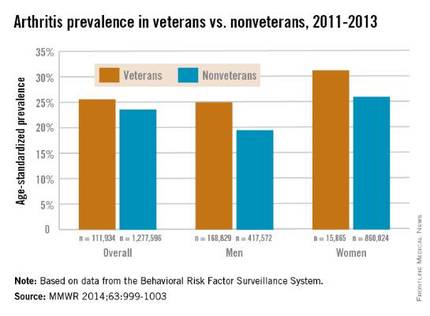
Both male and female veterans were more likely to have arthritis than were nonveterans, according to a study from the Centers for Disease Control and Prevention.
For male veterans, the age-standardized arthritis rate for 2011-2013 was 25%, while for male nonveterans, the rate was 19.5%. Both female veterans and nonveterans had noticeably higher arthritis incidence than did the respective male group: 31.3% for veterans and 26.1% for nonveterans, the CDC found (MMWR 2014;63:999-1003).
Although arthritis rates were higher overall in middle-aged and older people, arthritis rates were consistently higher in younger veterans aged 18-44 years – 11.6% for males and 17.3% for females – compared with 6.9% in male nonveterans and 9.8% in female nonveterans. This suggests “that arthritis and its effects need to be addressed among male and female veterans of all ages,” the CDC researchers said.
Traumatic and overuse injuries were found to be common among active-duty military personnel in another study, the investigators noted, while pointing out that musculoskeletal injuries are a major risk factor for osteoarthritis, which “represents the largest portion of arthritis cases” among veterans.
The study used data collected by the Behavioral Risk Factor Surveillance System.

Both male and female veterans were more likely to have arthritis than were nonveterans, according to a study from the Centers for Disease Control and Prevention.
For male veterans, the age-standardized arthritis rate for 2011-2013 was 25%, while for male nonveterans, the rate was 19.5%. Both female veterans and nonveterans had noticeably higher arthritis incidence than did the respective male group: 31.3% for veterans and 26.1% for nonveterans, the CDC found (MMWR 2014;63:999-1003).
Although arthritis rates were higher overall in middle-aged and older people, arthritis rates were consistently higher in younger veterans aged 18-44 years – 11.6% for males and 17.3% for females – compared with 6.9% in male nonveterans and 9.8% in female nonveterans. This suggests “that arthritis and its effects need to be addressed among male and female veterans of all ages,” the CDC researchers said.
Traumatic and overuse injuries were found to be common among active-duty military personnel in another study, the investigators noted, while pointing out that musculoskeletal injuries are a major risk factor for osteoarthritis, which “represents the largest portion of arthritis cases” among veterans.
The study used data collected by the Behavioral Risk Factor Surveillance System.

FROM MORBIDITY AND MORTALITY WEEKLY REPORT
Current use of COX-2 inhibitors linked to increased mortality after ischemic stroke
Current use of cyclooxygenase-2 inhibitors was associated with an increase in 30-day mortality after ischemic stroke in a population-based cohort study published Nov. 5 in Neurology.
Since the association between COX-2 inhibitors and ischemic stroke mortality was associated only with current use and not former use, the researchers, led by Dr. Morten Schmidt of Aarhus (Denmark) University Hospital, believe that alternative treatment options – such as nonselective NSAIDs, which did not have an impact on overall mortality after ischemic stroke – may be more suitable for treating potential ischemic stroke patients, such as those with atrial fibrillation and a high CHA2DS2-VASc score.
If the association is truly causal, it constitutes a strong argument for increasing the efforts to ensure that patients with a high predicted risk of arterial thromboembolism are not prescribed COX-2 inhibitors when alternative treatment options are available,” Dr. Schmidt and his associates wrote.
In order to determine whether COX-2 inhibitors influenced 30-day mortality at the time of hospitalization for stroke, the researchers examined records of 100,243 people hospitalized for a first-time stroke in Denmark during 2004-2012 and deaths within 1 month after the stroke (Neurology 2014 Nov. 5 [doi:10.1212/WNL.0000000000001024]).
The hazard ratio for ischemic stroke was 1.19 (95% confidence interval, 1.02-1.38) for current users of COX-2 inhibitors, while current users of nonselective NSAIDs had an HR of 1.00 (95% CI, 0.87-1.15), compared with nonusers.
The COX-2 inhibitors in the study included diclofenac, etodolac, nabumeton, and meloxicam, as well as coxibs including celecoxib and rofecoxib. The nonselective NSAIDs in the study were ibuprofen, naproxen, ketoprofen, dexibuprofen, piroxicam, tolfenamic acid, and indomethacin.
Though the researchers acknowledged more studies are needed to truly examine the effects of COX-2 inhibitors on stroke mortality, they hypothesized that the increased mortality rate may be caused by COX-2 inhibition interfering with the pathophysiologic response to a stroke, or unwanted effects from the thromboembolic properties of COX-2 inhibitors.
“Our study adds to the increasing body of evidence concerning the vascular risk and prognostic impact associated with use of COX-2 inhibitors,” Dr. Schmidt and his associates wrote.
The study was funded by several Danish research foundations and the Program for Clinical Research Infrastructure, which was established by the Lundbeck Foundation and the Novo Nordisk Foundation. The authors reported no relevant disclosures.
Current use of cyclooxygenase-2 inhibitors was associated with an increase in 30-day mortality after ischemic stroke in a population-based cohort study published Nov. 5 in Neurology.
Since the association between COX-2 inhibitors and ischemic stroke mortality was associated only with current use and not former use, the researchers, led by Dr. Morten Schmidt of Aarhus (Denmark) University Hospital, believe that alternative treatment options – such as nonselective NSAIDs, which did not have an impact on overall mortality after ischemic stroke – may be more suitable for treating potential ischemic stroke patients, such as those with atrial fibrillation and a high CHA2DS2-VASc score.
If the association is truly causal, it constitutes a strong argument for increasing the efforts to ensure that patients with a high predicted risk of arterial thromboembolism are not prescribed COX-2 inhibitors when alternative treatment options are available,” Dr. Schmidt and his associates wrote.
In order to determine whether COX-2 inhibitors influenced 30-day mortality at the time of hospitalization for stroke, the researchers examined records of 100,243 people hospitalized for a first-time stroke in Denmark during 2004-2012 and deaths within 1 month after the stroke (Neurology 2014 Nov. 5 [doi:10.1212/WNL.0000000000001024]).
The hazard ratio for ischemic stroke was 1.19 (95% confidence interval, 1.02-1.38) for current users of COX-2 inhibitors, while current users of nonselective NSAIDs had an HR of 1.00 (95% CI, 0.87-1.15), compared with nonusers.
The COX-2 inhibitors in the study included diclofenac, etodolac, nabumeton, and meloxicam, as well as coxibs including celecoxib and rofecoxib. The nonselective NSAIDs in the study were ibuprofen, naproxen, ketoprofen, dexibuprofen, piroxicam, tolfenamic acid, and indomethacin.
Though the researchers acknowledged more studies are needed to truly examine the effects of COX-2 inhibitors on stroke mortality, they hypothesized that the increased mortality rate may be caused by COX-2 inhibition interfering with the pathophysiologic response to a stroke, or unwanted effects from the thromboembolic properties of COX-2 inhibitors.
“Our study adds to the increasing body of evidence concerning the vascular risk and prognostic impact associated with use of COX-2 inhibitors,” Dr. Schmidt and his associates wrote.
The study was funded by several Danish research foundations and the Program for Clinical Research Infrastructure, which was established by the Lundbeck Foundation and the Novo Nordisk Foundation. The authors reported no relevant disclosures.
Current use of cyclooxygenase-2 inhibitors was associated with an increase in 30-day mortality after ischemic stroke in a population-based cohort study published Nov. 5 in Neurology.
Since the association between COX-2 inhibitors and ischemic stroke mortality was associated only with current use and not former use, the researchers, led by Dr. Morten Schmidt of Aarhus (Denmark) University Hospital, believe that alternative treatment options – such as nonselective NSAIDs, which did not have an impact on overall mortality after ischemic stroke – may be more suitable for treating potential ischemic stroke patients, such as those with atrial fibrillation and a high CHA2DS2-VASc score.
If the association is truly causal, it constitutes a strong argument for increasing the efforts to ensure that patients with a high predicted risk of arterial thromboembolism are not prescribed COX-2 inhibitors when alternative treatment options are available,” Dr. Schmidt and his associates wrote.
In order to determine whether COX-2 inhibitors influenced 30-day mortality at the time of hospitalization for stroke, the researchers examined records of 100,243 people hospitalized for a first-time stroke in Denmark during 2004-2012 and deaths within 1 month after the stroke (Neurology 2014 Nov. 5 [doi:10.1212/WNL.0000000000001024]).
The hazard ratio for ischemic stroke was 1.19 (95% confidence interval, 1.02-1.38) for current users of COX-2 inhibitors, while current users of nonselective NSAIDs had an HR of 1.00 (95% CI, 0.87-1.15), compared with nonusers.
The COX-2 inhibitors in the study included diclofenac, etodolac, nabumeton, and meloxicam, as well as coxibs including celecoxib and rofecoxib. The nonselective NSAIDs in the study were ibuprofen, naproxen, ketoprofen, dexibuprofen, piroxicam, tolfenamic acid, and indomethacin.
Though the researchers acknowledged more studies are needed to truly examine the effects of COX-2 inhibitors on stroke mortality, they hypothesized that the increased mortality rate may be caused by COX-2 inhibition interfering with the pathophysiologic response to a stroke, or unwanted effects from the thromboembolic properties of COX-2 inhibitors.
“Our study adds to the increasing body of evidence concerning the vascular risk and prognostic impact associated with use of COX-2 inhibitors,” Dr. Schmidt and his associates wrote.
The study was funded by several Danish research foundations and the Program for Clinical Research Infrastructure, which was established by the Lundbeck Foundation and the Novo Nordisk Foundation. The authors reported no relevant disclosures.
FROM NEUROLOGY
Key clinical point:Consideration should be given to using treatment options other than COX-2 inhibitors in patients with a high future risk of arterial thromboembolism.
Major finding: Preadmission use of COX-2 inhibitors was associated with increased 30-day mortality after ischemic stroke 1.19 (95% CI, 1.02-1.38), compared with nonusers.
Data source:Population-based cohort study of 100,043 patients from Denmark with first-time stroke.
Disclosures:The study was funded by several Danish research foundations and the Program for Clinical Research Infrastructure, which was established by the Lundbeck Foundation and the Novo Nordisk Foundation. The authors reported no relevant disclosures.
Eastern United States has the highest arthritis rates
The prevalence of arthritis tended to be higher in eastern U.S. states than in western states in 2011, according to a report from the Centers for Disease Control and Prevention.
All seven states with an arthritis rate below 22% were located west of the Mississippi River, with Hawaii having the lowest rate at 18.2%, followed by Utah (19.8%) and Texas (20.2%). The District of Columbia, which is in the East, had an arthritis rate of 20.9%.
The eight states with an arthritis rate greater than 29% were all east of the Mississippi, with West Virginia having the highest prevalence (35.9%), followed by Kentucky (31.9%) and Michigan (31.0%), according to the report (MMWR 2014;63[SS09]:1-149).
Of 198 reported metropolitan and micropolitan statistical areas (MMSAs), 29 had an arthritis prevalence lower than 20%. Lawrence, Kan., had the lowest rate at 13.5%. Of the 29, only Atlanta; Knoxville, Tenn.; and Raleigh, N.C., are located entirely east of the Mississippi River. Kingsport-Bristol, in Tennessee and Virginia, had the highest arthritis rate at 37%. Of the 16 MMSAs with an arthritis rate greater than 30%, North Platte, Neb., was the only one west of the Mississippi, according to data from the Behavioral Risk Factor Surveillance System.
The prevalence of arthritis tended to be higher in eastern U.S. states than in western states in 2011, according to a report from the Centers for Disease Control and Prevention.
All seven states with an arthritis rate below 22% were located west of the Mississippi River, with Hawaii having the lowest rate at 18.2%, followed by Utah (19.8%) and Texas (20.2%). The District of Columbia, which is in the East, had an arthritis rate of 20.9%.
The eight states with an arthritis rate greater than 29% were all east of the Mississippi, with West Virginia having the highest prevalence (35.9%), followed by Kentucky (31.9%) and Michigan (31.0%), according to the report (MMWR 2014;63[SS09]:1-149).
Of 198 reported metropolitan and micropolitan statistical areas (MMSAs), 29 had an arthritis prevalence lower than 20%. Lawrence, Kan., had the lowest rate at 13.5%. Of the 29, only Atlanta; Knoxville, Tenn.; and Raleigh, N.C., are located entirely east of the Mississippi River. Kingsport-Bristol, in Tennessee and Virginia, had the highest arthritis rate at 37%. Of the 16 MMSAs with an arthritis rate greater than 30%, North Platte, Neb., was the only one west of the Mississippi, according to data from the Behavioral Risk Factor Surveillance System.
The prevalence of arthritis tended to be higher in eastern U.S. states than in western states in 2011, according to a report from the Centers for Disease Control and Prevention.
All seven states with an arthritis rate below 22% were located west of the Mississippi River, with Hawaii having the lowest rate at 18.2%, followed by Utah (19.8%) and Texas (20.2%). The District of Columbia, which is in the East, had an arthritis rate of 20.9%.
The eight states with an arthritis rate greater than 29% were all east of the Mississippi, with West Virginia having the highest prevalence (35.9%), followed by Kentucky (31.9%) and Michigan (31.0%), according to the report (MMWR 2014;63[SS09]:1-149).
Of 198 reported metropolitan and micropolitan statistical areas (MMSAs), 29 had an arthritis prevalence lower than 20%. Lawrence, Kan., had the lowest rate at 13.5%. Of the 29, only Atlanta; Knoxville, Tenn.; and Raleigh, N.C., are located entirely east of the Mississippi River. Kingsport-Bristol, in Tennessee and Virginia, had the highest arthritis rate at 37%. Of the 16 MMSAs with an arthritis rate greater than 30%, North Platte, Neb., was the only one west of the Mississippi, according to data from the Behavioral Risk Factor Surveillance System.
FROM MORBIDITY AND MORTALITY WEEKLY REPORT
‘Prehabilitation’ cut postoperative care costs for total hip and knee replacements
Physical therapy before joint replacement surgery cut the predicted use of postoperative care by 29%, saving an estimated $1,215 in health care costs per patient, according to a Medicare claims analysis.
“These data are clinically relevant and can be used in the development of cost-effective and value-based total joint replacement programs,” said Dr. Richard Snow at OhioHealth in Columbus and his associates. The study is the first to evaluate the real-world link between preoperative physical therapy and use of postoperative care, the researchers said.
Numbers of total hip and knee replacements are projected to increase by 1.7 and 6.7 times, respectively, in the United States between 2005 and 2030, Dr. Snow and his coauthors noted. And while average length of hospital stay after these surgeries has dropped by more than 50%, there has been a substantial rise in per-patient costs of skilled nursing facilities, home health agencies, and inpatient rehabilitation, they said (J. Bone Joint Surg. 2014 Oct. 1 [doi:10.2106/JBJS.M.01285]).
The researchers analyzed 4,733 hip and knee replacement cases within a 39-county cluster of Medicare referral hospitals, and looked at the association between preoperative physical therapy (or “prehabilitation”) and use of postoperative care services in the 90 days after hospital discharge. Because of the skewed distribution of payments, the investigators looked only at cases that fell below the 95th percentile (or $41,113) for cost of care, they said.
In all, 79.7% of patients who did not undergo prehabilitation used acute care services after surgery, compared with 54.2% of patients who did (P < .0001). After controlling for comorbidities and demographic variables, prehabilitation was linked to an absolute reduction of 29% from the predicted to the observed rate of post-acute care use, saving an estimated average of $1,215 per patient, they said. Reductions in use of skilled nursing facilities, home health care services, and inpatient rehabilitation were the main drivers of the cost reduction, the researchers reported.
The findings support prior work indicating that prehabilitation can improve the value of care for patients undergoing total joint replacements, said Dr. Snow and his associates. “As the volume of arthroplasties expands within the framework of increasing health care costs, providers are under mounting pressure to identify the most cost-effective method of delivering high-quality, value-based health care,” they said.
Future studies should look at optimal ways to balance preoperative and postoperative care in specific populations of patients, the investigators said.
The research was partially supported by OhioHealth Research Institute. One or more authors reported financial relationships with biomedical entities deemed to possibly influence the research.
Physical therapy before joint replacement surgery cut the predicted use of postoperative care by 29%, saving an estimated $1,215 in health care costs per patient, according to a Medicare claims analysis.
“These data are clinically relevant and can be used in the development of cost-effective and value-based total joint replacement programs,” said Dr. Richard Snow at OhioHealth in Columbus and his associates. The study is the first to evaluate the real-world link between preoperative physical therapy and use of postoperative care, the researchers said.
Numbers of total hip and knee replacements are projected to increase by 1.7 and 6.7 times, respectively, in the United States between 2005 and 2030, Dr. Snow and his coauthors noted. And while average length of hospital stay after these surgeries has dropped by more than 50%, there has been a substantial rise in per-patient costs of skilled nursing facilities, home health agencies, and inpatient rehabilitation, they said (J. Bone Joint Surg. 2014 Oct. 1 [doi:10.2106/JBJS.M.01285]).
The researchers analyzed 4,733 hip and knee replacement cases within a 39-county cluster of Medicare referral hospitals, and looked at the association between preoperative physical therapy (or “prehabilitation”) and use of postoperative care services in the 90 days after hospital discharge. Because of the skewed distribution of payments, the investigators looked only at cases that fell below the 95th percentile (or $41,113) for cost of care, they said.
In all, 79.7% of patients who did not undergo prehabilitation used acute care services after surgery, compared with 54.2% of patients who did (P < .0001). After controlling for comorbidities and demographic variables, prehabilitation was linked to an absolute reduction of 29% from the predicted to the observed rate of post-acute care use, saving an estimated average of $1,215 per patient, they said. Reductions in use of skilled nursing facilities, home health care services, and inpatient rehabilitation were the main drivers of the cost reduction, the researchers reported.
The findings support prior work indicating that prehabilitation can improve the value of care for patients undergoing total joint replacements, said Dr. Snow and his associates. “As the volume of arthroplasties expands within the framework of increasing health care costs, providers are under mounting pressure to identify the most cost-effective method of delivering high-quality, value-based health care,” they said.
Future studies should look at optimal ways to balance preoperative and postoperative care in specific populations of patients, the investigators said.
The research was partially supported by OhioHealth Research Institute. One or more authors reported financial relationships with biomedical entities deemed to possibly influence the research.
Physical therapy before joint replacement surgery cut the predicted use of postoperative care by 29%, saving an estimated $1,215 in health care costs per patient, according to a Medicare claims analysis.
“These data are clinically relevant and can be used in the development of cost-effective and value-based total joint replacement programs,” said Dr. Richard Snow at OhioHealth in Columbus and his associates. The study is the first to evaluate the real-world link between preoperative physical therapy and use of postoperative care, the researchers said.
Numbers of total hip and knee replacements are projected to increase by 1.7 and 6.7 times, respectively, in the United States between 2005 and 2030, Dr. Snow and his coauthors noted. And while average length of hospital stay after these surgeries has dropped by more than 50%, there has been a substantial rise in per-patient costs of skilled nursing facilities, home health agencies, and inpatient rehabilitation, they said (J. Bone Joint Surg. 2014 Oct. 1 [doi:10.2106/JBJS.M.01285]).
The researchers analyzed 4,733 hip and knee replacement cases within a 39-county cluster of Medicare referral hospitals, and looked at the association between preoperative physical therapy (or “prehabilitation”) and use of postoperative care services in the 90 days after hospital discharge. Because of the skewed distribution of payments, the investigators looked only at cases that fell below the 95th percentile (or $41,113) for cost of care, they said.
In all, 79.7% of patients who did not undergo prehabilitation used acute care services after surgery, compared with 54.2% of patients who did (P < .0001). After controlling for comorbidities and demographic variables, prehabilitation was linked to an absolute reduction of 29% from the predicted to the observed rate of post-acute care use, saving an estimated average of $1,215 per patient, they said. Reductions in use of skilled nursing facilities, home health care services, and inpatient rehabilitation were the main drivers of the cost reduction, the researchers reported.
The findings support prior work indicating that prehabilitation can improve the value of care for patients undergoing total joint replacements, said Dr. Snow and his associates. “As the volume of arthroplasties expands within the framework of increasing health care costs, providers are under mounting pressure to identify the most cost-effective method of delivering high-quality, value-based health care,” they said.
Future studies should look at optimal ways to balance preoperative and postoperative care in specific populations of patients, the investigators said.
The research was partially supported by OhioHealth Research Institute. One or more authors reported financial relationships with biomedical entities deemed to possibly influence the research.
FROM JOURNAL OF BONE & JOINT SURGERY
Key clinical point: Physical therapy before total knee or total hip replacement surgeries can improve the value of care.
Major finding: In all, 79.7% of patients who did not undergo presurgical physical therapy used acute care services after surgery, compared with 54.2% of patients who underwent “prehabilitation” (P < .0001).
Data source: Medicare claims analysis of 4,733 total hip or knee replacement surgeries.
Disclosures: The research was partially supported by OhioHealth Research Institute. One or more authors reported financial relationships with biomedical entities deemed to possibly influence the research.
Acupuncture failed to reduce chronic knee pain
Neither traditional nor laser acupuncture is more effective than sham acupuncture at lessening pain or improving function in patients older than 50 years who have moderate to severe chronic knee pain, according to a report published online September 30 in JAMA.
In a randomized, partially blinded clinical trial, 282 participants aged 50 and older were randomly assigned to receive traditional needle acupuncture (70 patients), laser acupuncture (71 patients), sham laser acupuncture (70 patients), or no acupuncture (71 control subjects) in 20-minute sessions delivered once or twice weekly for 12 weeks.
At baseline, all the participants reported having moderate to severe knee pain and morning stiffness lasting less than 30 minutes on most days. They completed detailed questionnaires at baseline, 12 weeks, and 1 year measuring pain on walking or standing, physical function, activity restriction, health-related quality of life, and global change in knee pain and function over time, said Rana S. Hinman, Ph.D., of the Centre for Health, Exercise, and Sports Medicine, University of Melbourne, and her associates.
At 12 weeks and at 1 year, there were no significant differences in any of these outcomes between active acupuncture and sham acupuncture. Both needle and laser acupuncture improved pain at 12 weeks when compared with the control group, but this improvement was “of a clinically unimportant magnitude” and did not persist, the investigators said (JAMA 2014 September 30 [doi:10.1001/jama.2014.12660]).
Clinical guidelines vary with regard to acupuncture for knee osteoarthritis. The American College of Rheumatology “conditionally recommends” the treatment in patients who are candidates for arthroplasty, the Osteoarthritis Research Society International is “uncertain” about its efficacy, the European League Against Rheumatism failed to reach consensus on the treatment and doesn’t address it in final recommendations, the American Academy of Orthopedic Surgeons “cannot recommend” it, and the National Institute for Health and Care Excellence’s guidelines recommend against it. “The findings from our trial support these latter recommendations,” Dr. Hinman and her associates said.
Neither traditional nor laser acupuncture is more effective than sham acupuncture at lessening pain or improving function in patients older than 50 years who have moderate to severe chronic knee pain, according to a report published online September 30 in JAMA.
In a randomized, partially blinded clinical trial, 282 participants aged 50 and older were randomly assigned to receive traditional needle acupuncture (70 patients), laser acupuncture (71 patients), sham laser acupuncture (70 patients), or no acupuncture (71 control subjects) in 20-minute sessions delivered once or twice weekly for 12 weeks.
At baseline, all the participants reported having moderate to severe knee pain and morning stiffness lasting less than 30 minutes on most days. They completed detailed questionnaires at baseline, 12 weeks, and 1 year measuring pain on walking or standing, physical function, activity restriction, health-related quality of life, and global change in knee pain and function over time, said Rana S. Hinman, Ph.D., of the Centre for Health, Exercise, and Sports Medicine, University of Melbourne, and her associates.
At 12 weeks and at 1 year, there were no significant differences in any of these outcomes between active acupuncture and sham acupuncture. Both needle and laser acupuncture improved pain at 12 weeks when compared with the control group, but this improvement was “of a clinically unimportant magnitude” and did not persist, the investigators said (JAMA 2014 September 30 [doi:10.1001/jama.2014.12660]).
Clinical guidelines vary with regard to acupuncture for knee osteoarthritis. The American College of Rheumatology “conditionally recommends” the treatment in patients who are candidates for arthroplasty, the Osteoarthritis Research Society International is “uncertain” about its efficacy, the European League Against Rheumatism failed to reach consensus on the treatment and doesn’t address it in final recommendations, the American Academy of Orthopedic Surgeons “cannot recommend” it, and the National Institute for Health and Care Excellence’s guidelines recommend against it. “The findings from our trial support these latter recommendations,” Dr. Hinman and her associates said.
Neither traditional nor laser acupuncture is more effective than sham acupuncture at lessening pain or improving function in patients older than 50 years who have moderate to severe chronic knee pain, according to a report published online September 30 in JAMA.
In a randomized, partially blinded clinical trial, 282 participants aged 50 and older were randomly assigned to receive traditional needle acupuncture (70 patients), laser acupuncture (71 patients), sham laser acupuncture (70 patients), or no acupuncture (71 control subjects) in 20-minute sessions delivered once or twice weekly for 12 weeks.
At baseline, all the participants reported having moderate to severe knee pain and morning stiffness lasting less than 30 minutes on most days. They completed detailed questionnaires at baseline, 12 weeks, and 1 year measuring pain on walking or standing, physical function, activity restriction, health-related quality of life, and global change in knee pain and function over time, said Rana S. Hinman, Ph.D., of the Centre for Health, Exercise, and Sports Medicine, University of Melbourne, and her associates.
At 12 weeks and at 1 year, there were no significant differences in any of these outcomes between active acupuncture and sham acupuncture. Both needle and laser acupuncture improved pain at 12 weeks when compared with the control group, but this improvement was “of a clinically unimportant magnitude” and did not persist, the investigators said (JAMA 2014 September 30 [doi:10.1001/jama.2014.12660]).
Clinical guidelines vary with regard to acupuncture for knee osteoarthritis. The American College of Rheumatology “conditionally recommends” the treatment in patients who are candidates for arthroplasty, the Osteoarthritis Research Society International is “uncertain” about its efficacy, the European League Against Rheumatism failed to reach consensus on the treatment and doesn’t address it in final recommendations, the American Academy of Orthopedic Surgeons “cannot recommend” it, and the National Institute for Health and Care Excellence’s guidelines recommend against it. “The findings from our trial support these latter recommendations,” Dr. Hinman and her associates said.
Key clinical point: Acupuncture did not decrease chronic knee pain in patients over 50.
Major finding: No pain or function outcomes were significantly different between active and sham acupuncture at 12 weeks or 1 year.
Data source: A randomized, partially blinded Zelen-design clinical trial involving 282 older patients with moderate to severe knee pain who were treated for 12 weeks and followed for 1 year.
Disclosures: This study was funded by the National Health and Medical Research Council of Australia and the Australian Research Council. Dr. Hinman reported receiving royalties from the sale of the Gel Melbourne OA shoe (Asics), and her associates reported numerous ties to industry sources.
